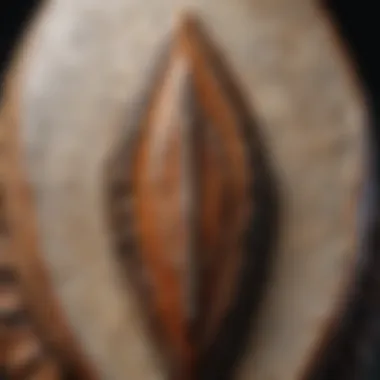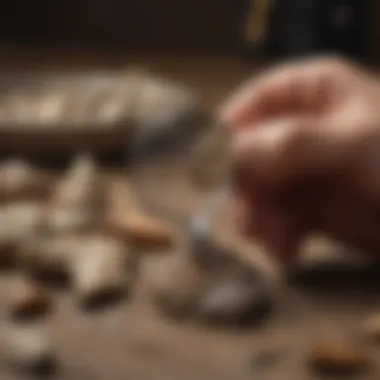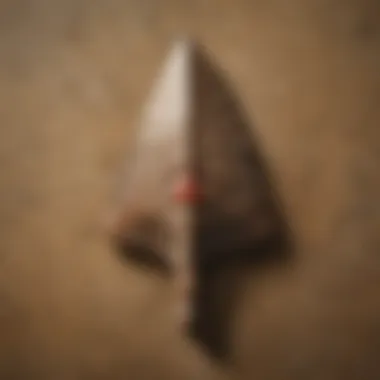Evaluating Arrowheads: A Guide for Collectors


Intro
Arrowheads have long captivated collectors, serving as tangible links to human history and prehistoric life. These artifacts possess not only aesthetic value but also significant historical and anthropological relevance. This guide aims to provide collectors with a comprehensive understanding of arrowhead valuation, focusing on various aspects such as historical context, material types, regional distinctions, and current market trends. Additionally, this article will touch on preservation methods and ethical collecting, offering a responsible approach to this engaging hobby.
As the interest in arrowheads continues to grow, both novice and experienced collectors seek clarity in assessing these artifacts. This guide will facilitate that process, ensuring that readers are well-equipped to understand the nuances involved in evaluating the worth of arrowheads.
Prelims to Arrowheads
Understanding arrowheads is essential for both novice and seasoned collectors. This section sets the stage for diving deeper into the methodologies for evaluating these artifacts. Arrowheads represent more than just tools; they embody a connection to history, culture, and human ingenuity. Collecting them can serve as a window into past civilizations and technologies.
The worth of an arrowhead extends beyond its material value. It envelops cultural significance, craftsmanship, and historical context. Collectors need to recognize these factors to make informed decisions. Without this foundation, enthusiasm for collecting may lead to regrets or misguided investments.
Definition and Purpose of Arrowheads
Arrowheads are pointed tools typically made from materials like stone, metal, or bone, designed primarily for use in hunting and warfare. Their design varies significantly based on culture, time period, and geographic location. The key function was to penetrate, wound, or kill game or enemies. However, they also serve an aesthetic purpose in collection as decorative items and educational artifacts.
Understanding the definition gives collectors a clear baseline from which to evaluate not just the object itself, but also its place in history. When assessing arrowheads, consider their design, the era they come from, and the techniques used in their creation. Recognition of these facets can increase both appreciation and value.
Historical Context of Arrowhead Use
The origin of arrowheads dates back thousands of years, playing a crucial role in early human survival and cultural practices. Cultures such as the Native Americans and ancient civilizations, like the Egyptians, utilized arrowheads for more than just hunting. They symbolize the technological advancement of societies and illustrate human adaptation.
Arrowheads often mark significant historical events or practices. For instance, the diversity in styles indicates varying methods of production and function tailored to specific needs or environments. These artifacts can provide insight into trade relationships, migration patterns, and shifts in economic systems.
A deeper understanding of historical contexts enriches the evaluation of arrowheads, enabling collectors to not only appreciate their aesthetic appeal but also their significant place in human history. By recognizing their importance, collectors can make more articulate appraisals and decisions.
Factors Influencing Arrowhead Value
Understanding the various factors that influence the value of arrowheads is crucial for both novice and experienced collectors. Several elements determine the worth of arrowheads in the market. Collecting arrowheads is not just about possession; it’s an exploration of history, culture, and craftsmanship. Collectors must be mindful of how these aspects can significantly affect valuation. Important factors include material composition, craftsmanship, and the item’s provenance or historical significance. Assessing all these factors helps in understanding market trends, which ultimately aids in making informed purchases.
Material Composition and Its Impact
The material from which an arrowhead is crafted plays a vital role in its value. Common materials include flint, obsidian, and chert, each with its unique characteristics. Flint has been prized for its durability and sharpness, making it a popular choice among early humans. Obsidian, known for its glassy texture and ability to be shaped into razor-sharp edges, is often considered more valuable.
Factors such as rarity, regional availability, and historical usage can also impact value. For example, arrowheads made from rare materials will often fetch higher prices. The age of a piece can contribute to its appeal as well.
Consider regularly checking market prices and relevant publications. Understanding the materials in your collection can help you assess their value more accurately.
Craftsmanship and Artistry
Craftsmanship significantly influences the worth of an arrowhead. The skill involved in creating an arrowhead can be seen through its shape, finish, and design. A well-made piece will often exhibit symmetry and precise flaking, indicating a high level of expertise. This is particularly relevant when it comes to ancient arrowheads, where understanding the workmanship can provide insights into the culture and time period from which it originates.
Intricate designs can also elevate an arrowhead's value beyond its basic functionality. For example, some arrowheads feature unique markings or carvings, which may suggest a ceremonial use or cultural significance. Authenticity in craftsmanship is paramount; replicas of less-skilled quality might be common but offer very little in terms of collector value.
Certain craftsmanship techniques, such as pressure flaking, can indicate a more skilled artisan and may raise the item's value accordingly. Collectors should pay attention to these details when evaluating their finds.
Provenance and Historical Significance
Provenance refers to the documented history of an object. In the context of arrowheads, the significance of provenance cannot be underestimated. The historical context can drastically change how an arrowhead is valued.
Arrowheads found in a context tied to a significant historical event or artifact gain immediate importance. Pieces with a documented history of use by an indigenous community can carry profound cultural significance, thereby increasing worth.


Moreover, having reliable documentation or certification regarding an arrowhead’s origin can appeal to collectors who value authenticity. Collectors are encouraged to consider records, such as archaeological finds or auction histories, when assessing their items.
"An arrowhead’s history can add layers of meaning, and value, that transcend mere physical attributes."
Regional Characteristics of Arrowheads
The evaluation of arrowheads goes beyond mere aesthetics and historical context. Understanding regional characteristics is vital for collectors who wish to assess the worth of their pieces accurately. Arrowheads are reflections of their geographical origins, which influence not only their design but also their function and value in the marketplace. Each region has unique styles and materials that define its arrowheads, making this aspect crucial for evaluation.
Appreciating these characteristics helps collectors identify genuine artifacts, avoid counterfeit pieces, and understand the narrative behind their collection. Every arrowhead carries with it a story of the culture and environment from which it originates. This section will explore diverse regional styles and variations and delve into how geographic provenance affects value trends in today’s market.
Regional Styles and Variations
Regional styles of arrowheads indicate the functional preferences and aesthetic choices of the cultures that created them. For instance, the spearheads made by the Clovis culture in North America showcase distinctive flaking patterns and shapes that were practical for hunting. In contrast, arrowheads from other places like the American Southwest often feature more intricate designs, reflecting the artistic expressions of their makers.
- Northeastern United States: Arrowheads such as the Madison and Levanna types exhibit innovation in shaping techniques suitable for the dense forests of the region.
- Southeastern United States: Styles here show ornamental features, including broader bases and more pointed tips, tailored for the hunting needs of the area.
- Western United States: The Great Basin region produces points like the Elko and Humboldt, which demonstrate adaptability to diverse hunting conditions and available materials.
Each of these styles provides insight into the technological advancements and cultural practices of specific regions. The variations that exist can signify not only artistic skill but also adaptation to local environments.
Geographic Provenance and Value Trends
The provenance of arrowheads refers to their geographical origins, which significantly impact their market value. It plays a critical role in the collector's assessment. Items with verified origins tend to command higher prices compared to those lacking clear historical context.
Collectors and appraisers look for specific archaeological records that confirm where a piece was found. For example, arrowheads sourced from historically significant sites such as Cahokia or Chaco Canyon often hold additional value due to their historical relevance.
- Current Trends: Recently, arrowheads from regions with a rich cultural heritage tend to see an increase in demand, driving prices upward. Arrowheads from less recognized areas may still hold value, but often not at the same level.
- Market Observations: Auctions frequently reflect a premium for regionally significant pieces. Notable sales in recent years have highlighted how geography can elevate an arrowhead's worth beyond basic material and craftsmanship evaluations.
Market Trends in Arrowhead Collecting
Understanding market trends in arrowhead collecting is fundamental for both seasoned and aspiring collectors. The value of arrowheads can fluctuate based on several factors including demand, historical significance, and the evolution of collecting practices. As these trends shift, being informed allows collectors to make strategic decisions about acquiring, selling, or valuing their collections.
Current Market Demand Analysis
The current market demand for arrowheads is characterized by a growing interest among collectors. Many enthusiasts are drawn not only by the aesthetics but also by the stories encapsulated in each piece. This increase in hobbyist engagement can be linked to several key factors:
- Cultural Interest: A renewed focus on indigenous cultures and histories has sparked curiosity about tools used by early humans.
- Educational Value: Arrowheads serve as tangible connections to history and anthropology, making them appealing both in personal collections and educational settings.
- Investment Potential: As collectibles, arrowheads are viewed as assets that can appreciate in value over time.
This demand has led to an increase in pricing for certain types and styles, particularly those that are rare or have documented provenance. Understanding the baseline for these prices requires thorough research and networking within the collecting community.
Auction Trends and Notable Sales
Auction houses have become pivotal in the arrowhead market, showcasing some extraordinary pieces that can fetch high prices. Recent notable sales have highlighted trends in what collectors are currently willing to pay. For example, arrowheads dating back several centuries or those made from unique materials often see significant interest.
Some points to consider about auction trends include:
- Rarity Matters: The rarer the arrowhead, the higher the bidding. This emphasizes the importance of provenance.
- Quality and Condition: Auction results indicate that well-preserved pieces consistently attract higher bids.
- Documentation: Pieces with clear historical background or authenticating documentation often sell for a premium.
Moreover, some of the most esteemed auction houses dedicate specific sales to the archeological and collectible materials, which indicates that the market is taken seriously by the broader auction community.
Impact of Online Platforms on Value
Online platforms have dramatically transformed how arrowheads are bought and sold. Websites like eBay, Facebook Marketplace, and specialized forums allow collectors to reach a wider audience. This shift has several implications for the value of arrowheads:


- Increased Accessibility: Collectors can find and trade pieces outside of their local markets.
- Price Transparency: Online listings allow collectors to easily compare prices, which affects perceived value across the board.
- Community Building: Platforms provide a space for collectors to share knowledge, tips, and appreciation for unique finds.
Despite the benefits, collectors must exercise caution when purchasing online. Misrepresentation is a concern; thus, verifying authenticity before transactions is essential.
In summary, the trends in the arrowhead market highlight a vibrant and dynamic arena for collectors. As interest grows, understanding these market dynamics becomes paramount for responsible collecting and investment.
Assessing the Market Value of Arrowheads
Understanding how to assess the market value of arrowheads is crucial for collectors. This not only helps in determining a fair price for buying or selling items but also aids collectors in building a valuable collection. The correct valuation can enhance one's appreciation of historical artifacts, while ensuring responsible acquisition practices.
Several factors influence the market value, including condition, provenance, and demand. Assessing the market involves a thorough investigation into these aspects. A nuanced understanding enhances the collector's ability to negotiate and make informed decisions in transactions. By focusing on the specific elements of value assessment, collectors can foster deeper connections with their artifacts.
Tools and Resources for Evaluation
When evaluating arrowheads, collectors can utilize various tools and resources. Here is a detailed look at some of the most important ones:
- Price Guides: Comprehensive price guides, such as those available in publications or online, can provide baseline values for specific types of arrowheads.
- Online Marketplaces: Websites like eBay or specialized auction sites offer insight into current market trends. Observing completed sales can indicate fair market values.
- Provenance Documentation: Having records that trace an arrowhead's history can dramatically increase its value. Documentation provides evidence of authenticity and significance, thus attracting potential buyers.
- Networking: Engaging with fellow collectors through forums and social media platforms, like Reddit or Facebook groups, can yield insights on valuation. Sharing information can help to compare similar pieces and assess market dynamics.
- Museum Resources: Many museums provide educational resources, including appraisals by experts. These professionals can offer details about rare pieces and educate collectors on valuation factors.
"The value of arrowheads is not only in their materials but also in their stories and histories."
Appraisal Process for Collectors
The appraisal process for arrowheads involves several key steps to ensure a comprehensive evaluation. Collectors should consider the following:
- Initial Inspection: Start by carefully examining the arrowhead for any damage or wear. Physical condition significantly impacts its value. Look for chips, cracks, and the integrity of the material.
- Research: Investigate the specific type of arrowhead. Factors such as age, origin, and maker can influence its worth. Historical context can be crucial when understanding its significance.
- Consult Experts: If possible, engage with skilled appraisers. They can provide professional insights and validate the authenticity of the piece. An expert assessment may be necessary for high-value items.
- Document Findings: Keep detailed records of all evaluations, including photographs and descriptions. Documentation enhances the arrowhead's marketability and helps retain its provenance.
- Current Market Comparison: Analyze similar items on the market. Note auction results and sales on platforms mentioned above to gauge price ranges.
By following these steps, collectors can systematically approach the valuation process, ensuring a well-rounded perspective on their arrowheads' worth.
Caring for and Preserving Arrowheads
Caring for and preserving arrowheads is a critical aspect for any collector. These artifacts not only have historical value but also represent significant cultural heritage. Proper care ensures that the arrowheads can be maintained for future generations, allowing continuous appreciation and study of these items.
Effective preservation includes several key practices. Collectors should be aware of the material composition of their arrowheads, as different materials require distinct care strategies. Arrowheads made from stone, for instance, might be more resilient than those crafted from glass or ceramics. Understanding these nuances can help prevent deterioration.
Safe Handling and Storage Techniques
Safe handling and storage techniques are essential for maintaining the integrity of arrowheads. Collectors must approach their artifacts with care to avoid accidental damage that can drastically reduce value.
When handling arrowheads, it is critical to:
- Use gloves: Always wear clean, soft gloves to avoid transferring oils or dirt from your hands onto the artifact.
- Support the piece: Never hold arrowheads only by their tips or points. Use two hands when lifting them, supporting the base and sides.
- Create a safe environment: Ensure that the area where you handle items is free from clutter and potential hazards.
For storage, here are some best practices:
- Use display cases: Invest in UV-protected display cases to minimize exposure to light, which can lead to fading.
- Avoid damp places: Store your artifacts in a dry location to reduce the risk of mold or corrosion.
- Keep away from extreme temperatures: Sudden changes in temperature can cause materials to expand or contract, leading to cracks.
Cleaning and Restoration Practices
Cleaning and restoration require a delicate balance. Collectors need to be cautious not to damage the artifact while trying to preserve it. Depending on the material, cleaning methods will vary significantly.
For cleaning arrowheads, consider the following points:


- Use soft brushes: For loose dirt or debris, a soft brush is often sufficient. Avoid using water unless the material allows it, as moisture can lead to deterioration.
- Avoid harsh chemicals: Strong cleaners can affect the surface finish. Stick to mild solutions, if necessary, or consult a specialist.
- Understand restoration limits: In some cases, restoration can impact an artifact's value. Proper restoration should focus on preserving as much of the original material as possible.
“Proper care not only preserves the beauty but protects the historical significance of each arrowhead.”
Legal and Ethical Considerations
Collecting Laws and Regulations
Understanding the legal framework surrounding arrowhead collecting is essential for any collector, whether novice or expert. The legality of collecting arrowheads varies significantly by geographic location. In the United States, for instance, various laws govern the collection of Native American artifacts, including arrowheads. The Archaeological Resources Protection Act (ARPA) strictly prohibits the excavation or removal of artifacts from public lands without a permit. Violating this law can result in hefty fines and possible imprisonment.
In addition, some states implement their own regulations regarding the collection of artifacts from private land. It is crucial for collectors to ascertain whether they have permission from landowners before removing any items. Local ordinances can further complicate the situation, making it imperative to research specific collecting laws in one's area. Failing to do this can lay collectors open to legal action, potentially tarnishing their reputation and standing within the community.
Here are some key points to consider regarding collecting laws and regulations:
- Public vs. Private Land: Always seek permission when collecting on private property. Public land often has stricter rules.
- State-Specific Laws: Different states have unique laws related to artifact collection. Research your state’s regulations thoroughly.
- Permits Required: Be aware that some jurisdictions require permits for artifact excavation.
"Informed collectors protect not only their interests but also those of future generations by adhering to the laws that govern archaeological resources."
Ethical Collecting Practices
Ethics in arrowhead collecting transcends legality. It is about respecting the cultural heritage and history associated with the artifacts. Collectors have an obligation to consider the implications of their actions. Ethically collecting arrowheads means not only following laws but also engaging respectfully with the communities whose histories these artifacts represent.
Practicing ethical collecting can take many forms:
- Respect Cultural Significance: Acknowledge the importance of arrowheads and other artifacts to indigenous communities. Understand the narratives they hold.
- Avoid Looting: Collect only items that have been legally obtained. This practice preserves the integrity of archaeological contexts and ensures responsible stewardship.
- Share Knowledge: Engage with others in the community by sharing insights, discoveries, and best practices regarding ethical collecting. This creates a culture of respect and awareness.
- Consider Donations: Sometimes, collectors might find they possess items of significant historical value. In such cases, considering donations to museums or academic institutions can be morally sound and beneficial for historical conservation.
Understanding both the legal and ethical dimensions of arrowhead collecting contributes to a responsible and informed community of collectors. This enhances the enjoyment of the hobby while safeguarding the integrity of the artifacts and the cultures from which they originate.
The Future of Arrowhead Collecting
The realm of arrowhead collecting is evolving. As more individuals develop an interest in this hobby, the landscape is changing in meaningful ways. Understanding the future of arrowhead collecting is crucial for both seasoned enthusiasts and newcomers. This section will examine emerging trends, possible innovations, and the impact of community involvement on the collecting landscape. Collectors must pay attention to these elements to adapt and thrive in the shifting dynamics of the field.
Emerging Trends and Innovations
Today's collectors are witnessing several significant trends that can reshape how arrowheads are valued and collected. Digital tools are making it easier to connect collectors, researchers, and enthusiasts. Online platforms and social media enable sharing of knowledge and experiences, thereby fostering a vibrant community. Here are some key trends to note:
- Virtual Exhibitions: Many museums are now offering virtual tours showcasing collections of arrowheads. This makes it easier for collectors to learn and appreciate various styles from different regions without geographical limitations.
- Advancements in Technology: Developments in 3D printing could allow collectors to replicate rare arrowheads. This technology can serve both preservation and educational purposes, providing a way to display replicas while preserving originals in suitable conditions.
- Sustainable Practices: As awareness about environmental issues grows, collectors are increasingly focused on the sustainability of their collecting habits. Ethically sourcing pieces is becoming a priority, and this trend is likely to influence market dynamics.
These trends not only demonstrate a shift in how collectors engage with arrowheads but also point toward a future where technology and ethical considerations play a central role.
Community Engagement and Education
One of the most promising aspects of the future of arrowhead collecting is the potential for community engagement and educational initiatives. The sharing of knowledge among collectors can elevate the entire community, transforming mere hobbyists into informed participants. Here are several ways community engagement can enhance the field:
- Workshops and Seminars: Local clubs and societies can organize workshops to educate both novices and experienced collectors about valuation techniques, restoration methods, and historical context.
- Online Forums: Leveraging platforms like Reddit and Facebook can provide collectors with access to a wealth of information. Online groups enable discussions, the sharing of tips, and even advice on appraisals.
- Field Schools: Innovative programs that combine education with fieldwork offer hands-on experience. Participants learn about archaeology while actually searching for arrowheads. This can enrich the understanding of historical and geological significance.
Closure
In the realm of arrowhead collecting, understanding the value of these artifacts is crucial for both novice and seasoned collectors. This guide has explored the various factors that affect the worth of arrowheads, ranging from material composition to regional styles and market trends. Each detail contributes to a more comprehensive appraisal of these items, aiding collectors in making informed decisions.
The evaluation of arrowheads is not merely about financial considerations. These artifacts embody historical significance and cultural narratives that expand one's appreciation for archaeology and anthropology. As collectors arm themselves with knowledge, they also engage in a dialogue with history. This interaction enriches their collections and builds a connection to the wider community of enthusiasts.
Moreover, ethical considerations remain a fundamental aspect in the process of collecting. Learning the laws and adopting responsible practices ensures the preservation of history for future generations. Collectors who uphold these principles not only sustain the hobby but also foster positive relationships within the community.
As stated in the earlier sections, market dynamics fluctuate; however, possessing a solid understanding of these variables can enhance a collector's experience. Whether through attending auctions, engaging in online platforms, or participating in community events, the potential for growth and learning is substantial.
"Knowledge empowers collectors, guiding them through the intricacies of value assessment and ethical engagement."
Ultimately, as this guide highlights, the journey of collecting arrowheads transcends mere acquisition. It transforms into an exploration of culture, history, and human connection. By synthesizing all these elements, collectors position themselves not just as amateurs, but as stewards of the past who contribute to a deeper understanding of humanity's shared heritage.



